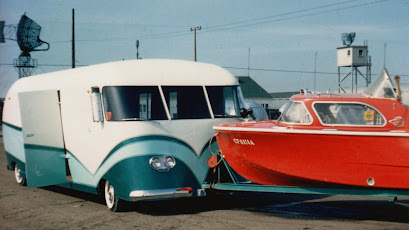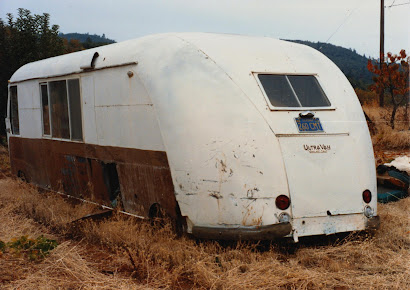The 24 foot long coach was designed around the remains of a wrecked 1960 Corvair sedan; incorporating the 80 horsepower engine, two speed Powerglide automatic transmission, front and rear suspension, headlights, tail lights, and instrument panel. The windshields were sourced from a Chevrolet stepvan, the bumpers from a '47-55 Chevy pickup, and most everything else was hand built from riveted aluminum and fiberglass by Peterson himself.
For maximum living space, the coach was a full 8 feet (96 inches) wide at the top. To work with the suspension from the 67 inch wide car Peterson developed a unique reverse-tumblehome body shape that narrowed the body to just 86 inches inches at the bottom. Then he cut out the car's front suspension crossmember, moved the two remaining assemblies apart, and riveted them to the coach structure. In the rear he added ornamental dually rear wheels to fill out the wheel wells. To insure the dually wheels wouldn't overload the car's suspension he kept them at a very low air pressure.
The rear body was shaped to resemble Peterson's beloved Spartan travel trailer. Remarkably, both fiberglass rear corner panels were created using the same mold, but one of the panels was flipped inside out when the resin was partially cured. Two tow hitches were installed - one on the rear to tow his 1958 Dorsett Catalina, and a second on the front to launch and recover the boat.
Without any interior furnishings the revolutionary coach weighed less than 1,800 lbs empty - "Five times the cube of the VW Van and 400 lbs lighter", or "one-half the weight of a Greenbrier and over twice the space." Even after the finished interior was installed it still weighed under 3,000 lbs.
Peterson (David G.) and his son (David L.) operated the coach until at least 1973, at some point modifying the side windows to more closely resemble the production UltraVans. Then for one and a half dozen years the coach passed out of all knowledge into history and legend. Eventually rumors of an unusual UltraVan came to Jim Craig via his friend Mory Snyder, and together they tracked down the prototype rotting away in a grape field near Oroville, California.
Recovery was accomplished by April 1990, and a Club restoration project was organized with many donations of time, labor, parts, and even cash. By 2001 interest had waned; only one couple showed up to the final Restoration Rally. In 2003 the coach found a new home at the Lane Motor Museum in Nashville Tennessee (profits from the sale were returned to the Club). Lane displayed the coach until early 2014, when it was purchased by Craig & Lea Lamond and driven to Portland Oregon. The Lamonds plan to return the prototype UltraVan to its original configuration.
A collection of photos of the Prototype can be seen here::
https://www.flickr.com/photos/8769347@N03/sets/72157644794709346/
April 1990 discovery and recovery:
http://imgur.com/a/dUqUt
April 1994 Restoration Rally:
http://imgur.com/a/87mvG
November 1994 Restoration Rally:
http://imgur.com/a/UQRyc
May 1995 Restoration Rally:
http://imgur.com/a/A3jtX
More restoration photos:
http://imgur.com/a/zJ2pX



Thanks to Jim Craig for his hard work and organization this historic Ultra Van has been saved from destruction, otherwise it may have been lost forever.
ReplyDelete